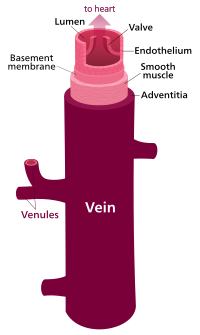
Photo from wikipedia
Background Lead-related venous stenosis/obstruction (LRVSO) may be a major challenge in patients with cardiac implantable electronic devices (CIED) when device upgrade, insertion of central lines, or creation of an arteriovenous… Click to show full abstract
Background Lead-related venous stenosis/obstruction (LRVSO) may be a major challenge in patients with cardiac implantable electronic devices (CIED) when device upgrade, insertion of central lines, or creation of an arteriovenous fistula for hemodialysis is indicated. The aim of this study was to evaluate the extent and severity of LRVSO. Methods We performed a retrospective analysis of 3002 venograms from patients awaiting transvenous lead extraction (TLE) to assess the occurrence, severity, and extent of LRVSO. Results Mild LRVSO occurred in 19.9%, moderate in 20.7%, severe in 19.9% and total venous occlusion in 22.5% of the patients. Moderate/severe stenosis or total occlusion of the subclavian and brachiocephalic veins was found in 38.2% and 22.5% of the patients, respectively. LRSVO was not detected in 16.9% of the patients. Moderate and severe superior vena cava (SVC) obstruction and total SVC occlusion were rare (0.4%, 0.3%, and 0.3%, respectively). Lead insertion on the left side of the chest contributed to an increased risk of LRVSO compared to right-sided implantation. Major thoracic veins on the opposite side may be narrowed in varying degrees. Conclusion A total of 60% of the patients with pacemaker or high-voltage leads have an advanced form of LRVSO. Any attempt to insert new pacing leads, central lines, venous ports, or catheters for hemodialysis, or to create dialysis fistula on the same side as the existing lead should be preceded by venography. Furthermore, venography may provide useful information, if it is planned to implant the lead or the catheter on the opposite side of the chest.
Journal Title: Vascular Health and Risk Management
Year Published: 2022
Link to full text (if available)
Share on Social Media: Sign Up to like & get
recommendations!